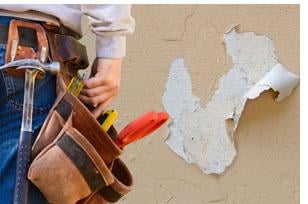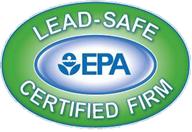EPA Lead-Safe Certified Firm Logo Use Guidelines
Guidelines for use of the Certified Firm Logo provided by EPA must be followed to avoid fines. Reading and understanding the following information can help make sure you are in compliance if you plan to use the firm logo on your vehicles, signage and or any marketing you do.
What is the Lead-Safe Certified Firm Logo?
The Lead-Safe Certified Firm Logo identifies a firm as certified under the Renovation, Repair, and Painting (RRP) Rule. The colors used to make the two-color logo are Pantone 362C (green) and Pantone 660C (blue). The font is Helvetica.
What are the guidelines for using the Logo?
The Logo must be reproduced so that all of its components are legible and includes your firm's certification number. The Logo must not be altered or distorted in any way.
You MAY --
- Use the Logo to identify your firm as an RRP-certified firm. Firms that are not RRP-certified may not use the Logo.
- Use the Logo in brochures, advertisements, Web sites, proposals, bills, signs, uniforms, vehicles and other materials promoting or identifying your firm.
- Use the Logo on documents or other materials in black and white or color (two-color or four-color versions are available).
You MAY NOT --
- Use the Logo in any manner that would imply EPA endorsement of a company, its products or services.
- Reduce the Logo to a size smaller than one inch wide by 0.687 inches in height.
- Allow a firm that is not RRP-certified (including your subcontractors) to use the Logo.
EPA will monitor the use of all Logos. If necessary, EPA will address failure to comply with these Logo Guidelines. To report a non-compliant use of the Logo, please contact EPA at 1-800-424-LEAD.
EPA will e-mail information regarding your custom Logo to the e-mail address listed on your firm certification application.
For further questions regarding your EPA Lead-Safe Certified firm Logo, please send an email to: EPARRPFirmLogo@battelle.org or send a fax to: (202) 566-0470. In your email/fax please include your EPA Firm Certification number (e.g., NAT-12345-1), Application ID (e.g., 12345), firm name, and firm mailing address.
EPA Lead-Safe Certified Firm Logo - Information for Training Providers
Accredited training providers may use the Logo on their site and marketing materials as long as it is used as a tool to guide renovators through the firm certification process (i.e., explain the difference between firm certification and individual training). Training providers may inform students that only certified firms will be provided a customized Logo exclusively for their use to advertise their businesses once their firm has been certified. Training providers may distribute the Logo only to principal instructors affiliated with the accredited provider, and only for the purpose of training as described above. Training providers may NOT distribute the Logo to unaffiliated entities. Upon request, EPA will provide to accredited training provider the Logo for their use. Requests can be made to the National Lead Information Center at 1-800-424-LEAD.
Principal instructors that advertise, provide training, and use the Logo must do so under the name of the accredited training provider for whom they work. They may also state that the organization that employs them, if different from the accredited training provider, is assisting with the training.
Information for Press and Marketing Entities
Press and other marketing entities may use the logo on their site and marketing materials provided it does not include a certification number. They may NOT:
- Distribute or provide a downloadable version of the logo
- Indicate association, endorsement or approval from EPA
- Imply lead-safe certification from EPA or any EPA-authorized state.
Upon request, EPA will provide the logo for use.
Note: The information shown above is from the EPA web site. EPA has already and may again revise these guidelines. Use this link to find the most recent info at the EPA web site.

 Looking for accurate information about the EPA RRP rule?
Looking for accurate information about the EPA RRP rule? 
 As EPA amends the RRP rule, renovators working in states that have taken over the rule from EPA need to know if and how these states incorporate the changes into their own rule. Yesterday I inquired with the State of Massachusetts to find out about a few recent amendments and changes.
As EPA amends the RRP rule, renovators working in states that have taken over the rule from EPA need to know if and how these states incorporate the changes into their own rule. Yesterday I inquired with the State of Massachusetts to find out about a few recent amendments and changes. Question: Can you tell me if MA allows the lead safe renovation supervisor to take paint chip samples same as EPA does?
Question: Can you tell me if MA allows the lead safe renovation supervisor to take paint chip samples same as EPA does? Question: Also, does MA now recognize LeadCheck for Drywall and Plaster?
Question: Also, does MA now recognize LeadCheck for Drywall and Plaster?
 In reality what they have done has not been effective. Either the message is not effective, the placement is not effective or both. According to a
In reality what they have done has not been effective. Either the message is not effective, the placement is not effective or both. According to a 

 So far EPA has only published one violation since the rule came into effect in April of 2010. On the other hand the state of Massachusetts took over the rule in July of 2012 and has
So far EPA has only published one violation since the rule came into effect in April of 2010. On the other hand the state of Massachusetts took over the rule in July of 2012 and has  It is a fact that lead is poisonous and RRP activities can cause poisoning. However, EPA does not know how many children were actually poisoned by RRP activities before the rule came into effect. If you check any of the data it refers to RRP activities as the “likely source” of lead poisoning, not “the cause”. That being the case, EPA has no way to know if the RRP rule is making a difference or not. It is ‘likely” that it is helping. But, without knowing where EPA started and where we are now that the rule has been in place for almost a year, EPA has no idea if what they have been doing is effective enough and or if or where it can improve effectiveness within the rule.
It is a fact that lead is poisonous and RRP activities can cause poisoning. However, EPA does not know how many children were actually poisoned by RRP activities before the rule came into effect. If you check any of the data it refers to RRP activities as the “likely source” of lead poisoning, not “the cause”. That being the case, EPA has no way to know if the RRP rule is making a difference or not. It is ‘likely” that it is helping. But, without knowing where EPA started and where we are now that the rule has been in place for almost a year, EPA has no idea if what they have been doing is effective enough and or if or where it can improve effectiveness within the rule. 


 So it appears that a non-certified firm can do the work if testing that proved no lead was found was done by someone else, as long as the determination was made by a certified lead inspector or risk assessor, or by a certified renovator using an EPA recognized test kit and following the kit manufacturer’s instructions. The key is however, that the non-certified firm must have written proof from the person or business that did the testing that there is no lead in the work areas to be disturbed.
So it appears that a non-certified firm can do the work if testing that proved no lead was found was done by someone else, as long as the determination was made by a certified lead inspector or risk assessor, or by a certified renovator using an EPA recognized test kit and following the kit manufacturer’s instructions. The key is however, that the non-certified firm must have written proof from the person or business that did the testing that there is no lead in the work areas to be disturbed. There has been a lot of confusion regarding the details of the EPA RRP rule. One that seems to pop up over and over is certification requirements for sub contractors. There are two different certification considerations regarding sub contractors; firm certification and worker certification. Let’s take a look at each separately.
There has been a lot of confusion regarding the details of the EPA RRP rule. One that seems to pop up over and over is certification requirements for sub contractors. There are two different certification considerations regarding sub contractors; firm certification and worker certification. Let’s take a look at each separately. Whether working for the general contractor as a trade partner or a 1099 sales person (offers the work), sub contractors must become certified firms by apply for certification through the EPA. Ensuring that the subs they use are certified firms is particularly important for general contractors, because as part of the required documentation under the rule, the renovation checklist must include the names of all workers who participated in RRP activities on the job. If a sub contractor and his workers do work on the job and the sub’s firm is not certified, the EPA will easily be able to find both the general contractor and the sub in violation of the rule. If a general contractor knows that subs must be certified firms, hiring a non-certified firm to work on a job becomes a knowing and willful violation of the rule, which brings with it serious penalties. It’s also one easy way for a customer’s lawyer to suggest the contractor is/was negligent.
Whether working for the general contractor as a trade partner or a 1099 sales person (offers the work), sub contractors must become certified firms by apply for certification through the EPA. Ensuring that the subs they use are certified firms is particularly important for general contractors, because as part of the required documentation under the rule, the renovation checklist must include the names of all workers who participated in RRP activities on the job. If a sub contractor and his workers do work on the job and the sub’s firm is not certified, the EPA will easily be able to find both the general contractor and the sub in violation of the rule. If a general contractor knows that subs must be certified firms, hiring a non-certified firm to work on a job becomes a knowing and willful violation of the rule, which brings with it serious penalties. It’s also one easy way for a customer’s lawyer to suggest the contractor is/was negligent. At a RRP workshop I attended last week, sponsored by the Lead and Environmental Hazards Association (LEHA), several renovators complained to Mike Wilson of EPA about EPA’s handling so far of the RRP rule. One after the other renovators cited examples of projects they had lost to other businesses that are ignoring the rule. Several even reported home owners had laughed at them when they tried discussing the rule and its requirements. One attendee reported that a homeowner actually told him that he would find another contractor who would ignore the rule as a way of saving money. It all seemed to be new news to Mike Wilson who told us he oversees RRP Policy, so could not comment specifically about enforcement. When asked what message he would bring back to the EPA in Washington after the meeting, Mike said he would let them know that regulated contractors wanted a level playing field. Attendees let Mike know that they have been already giving that same message to EPA, perhaps if Mike delivers the message the leadership at EPA will listen and take action.
At a RRP workshop I attended last week, sponsored by the Lead and Environmental Hazards Association (LEHA), several renovators complained to Mike Wilson of EPA about EPA’s handling so far of the RRP rule. One after the other renovators cited examples of projects they had lost to other businesses that are ignoring the rule. Several even reported home owners had laughed at them when they tried discussing the rule and its requirements. One attendee reported that a homeowner actually told him that he would find another contractor who would ignore the rule as a way of saving money. It all seemed to be new news to Mike Wilson who told us he oversees RRP Policy, so could not comment specifically about enforcement. When asked what message he would bring back to the EPA in Washington after the meeting, Mike said he would let them know that regulated contractors wanted a level playing field. Attendees let Mike know that they have been already giving that same message to EPA, perhaps if Mike delivers the message the leadership at EPA will listen and take action. I recently completed a series of seven videos about the new EPA RRP rule. The RRP videos were done for Remodeling magazine. They are posted to the Remodeling TV area of Remodeling magazine’s web site.
I recently completed a series of seven videos about the new EPA RRP rule. The RRP videos were done for Remodeling magazine. They are posted to the Remodeling TV area of Remodeling magazine’s web site. writing the script, interviewing contributors, editing the script with the magazine’s editor Sal Alfano, reviewing the raw footage, and working with the videographer,
writing the script, interviewing contributors, editing the script with the magazine’s editor Sal Alfano, reviewing the raw footage, and working with the videographer, 
 I suggest you check out the introduction section in the policy document. Although the policy document is intended to provide guidelines for EPA Enforcement staff, the document introduction also states:
I suggest you check out the introduction section in the policy document. Although the policy document is intended to provide guidelines for EPA Enforcement staff, the document introduction also states:  Many liability insurance policies do not cover lead poisoning or contamination. Renovators should be sure they are working with an agent who is up on the EPA RRP rule and should sit down with their agent to review their coverage needs and options.
Many liability insurance policies do not cover lead poisoning or contamination. Renovators should be sure they are working with an agent who is up on the EPA RRP rule and should sit down with their agent to review their coverage needs and options.  One other area that will likely be of concern is lead coverage in policies for landlords who own pre-1978 properties. Here too, compliance with RRP rules and documentation of work practices used for renovations and repairs will likely become required conditions of obtaining and keeping coverage. The EPA RRP rule may also cause an increase in insurance coverage on properties built prior to 1978, for landlords and maybe even home owners.
One other area that will likely be of concern is lead coverage in policies for landlords who own pre-1978 properties. Here too, compliance with RRP rules and documentation of work practices used for renovations and repairs will likely become required conditions of obtaining and keeping coverage. The EPA RRP rule may also cause an increase in insurance coverage on properties built prior to 1978, for landlords and maybe even home owners.


